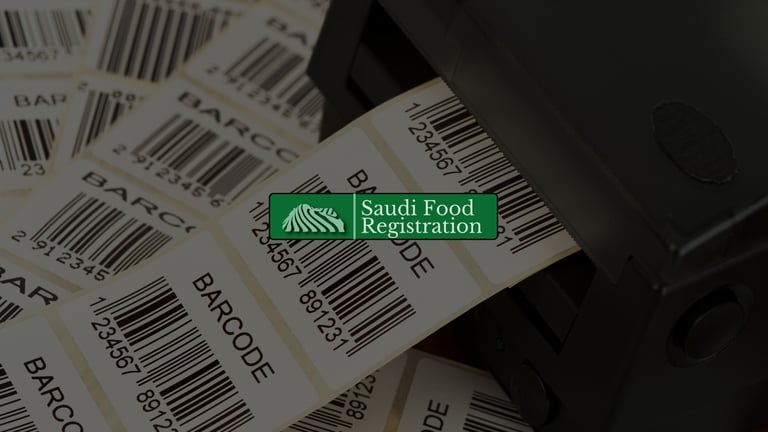Master SFDA Barcode Rules for Food Products in Saudi Arabia
Avoid costly delays by mastering SFDA barcode requirements in KSA. Learn GTIN, placement, and labeling rules to keep your product compliant and import-ready.
7/31/20253 min read


SFDA Barcode Requirements in Saudi Arabia:
A Complete Guide for Food Products
When registering food or supplement products in Saudi Arabia, many companies overlook one critical detail: barcode compliance.
While it may seem simple, SFDA (Saudi Food and Drug Authority) barcode requirements are tightly enforced, and a small error can delay or even reject your product registration.
In this blog, we break down everything you need to know about SFDA barcode standards, from GS1 registration to label placement, verification, and post-market enforcement.
What Is an SFDA-Compliant Barcode?
The SFDA requires all products under its authority to have a valid GS1 barcode — also known as a Global Trade Item Number (GTIN).
This ensures product traceability and alignment with international standards.
The barcode links to the product's registration in the SFDA system and is used throughout import, inspection, and sales.
Barcodes must:
Be GS1-registered and verifiable
Match the product information exactly
Be printed in scannable format (usually EAN-13)
Appear clearly on the label or outer packaging
Do You Need a GS1 License from Saudi Arabia?
Although GS1 operates globally, many businesses opt to register through GS1 Saudi Arabia to minimize compliance risks.
Using barcodes from other countries may lead to additional checks or misalignments with SFDA expectations.
Key registration steps include:
Obtaining a GS1 company prefix suitable for your operations
Assigning GTINs accurately to each product
Keeping all barcode data synchronized with your regulatory records
Once issued, your GTIN becomes an essential part of the SFDA registration process.
Barcode Placement & Labeling Rules
Barcode visibility and placement are critical to avoid import delays or SFDA inspection issues.
Best practices for SFDA barcode placement:
Place on the back or bottom of the product (not wrapped around a curve)
Avoid placing over seams or folds
Maintain minimum contrast and quiet zones
Use label material that prevents smudging or fading
For multi-pack or outer packaging (e.g., cartons), a separate barcode may be required with different GTINs per packaging level.
Barcode Verification & SFDA Audits
Before launching your product, perform a barcode verification test using GS1-approved tools or services.
SFDA inspectors may scan barcodes during customs clearance, random audits, or retail monitoring.
Your GTIN must match:
Product name
Brand
Weight or volume
Packaging type
Any mismatch between SFDA registration data and the barcode-linked data could cause rejections, fines, or reclassification.
Common Mistakes to Avoid
Avoid these frequent errors during SFDA barcode compliance:
Using unregistered barcodes or expired GTINs
Applying barcodes from another company or brand
Poor print quality or incorrect size
Mismatch between label data and barcode data
Companies often underestimate this step, thinking it’s only for retailers. In reality, it’s a critical compliance layer in the SFDA system.
Does SFDA Require 2D Barcodes or QR Codes?
As of now, 1D barcodes (like EAN-13) are the main standard. However, 2D codes (like DataMatrix or QR) are increasingly used for batch traceability, especially in pharmaceuticals and medical devices. SFDA may expand requirements in the future, so stay up to date.
Final Tips to Stay Compliant
Register your GTINs through GS1 Saudi Arabia when possible
Ensure your label file includes the barcode in the correct format
Perform test scans across different production batches
Always double-check alignment with SFDA's registered product data
Staying ahead of barcode compliance isn’t just about printing a label—it’s about protecting your import pipeline and maintaining trust with SFDA.
FAQs About SFDA Barcode Requirements
1. What happens if my barcode is rejected by SFDA?
Your product may be held at customs, returned, or require a reapplication.
2. Can I use the same barcode for different pack sizes?
No. Each packaging level (single, carton, display) must have a unique GTIN.
3. Is GS1 registration mandatory for all products?
Yes, all regulated products must have GS1-registered GTINs linked to their SFDA files.
4. Can I generate barcodes online for free instead of using GS1?
No. SFDA only accepts officially registered GS1 barcodes.
5. What if I change my packaging after SFDA approval?
You must update SFDA and ensure the new barcode still matches all registered data.
Need help aligning your barcode with SFDA standards?
Our team can guide you through barcode registration, verification, and labeling compliance.
Use the chatbot in the corner or reach out directly to get started.
Recommended Reads:
Explore deeper compliance tips in Get SFDA Approval for Multi-Ingredient Products Fast
Learn key labeling pitfalls in How to Prevent SFDA Rejections at the Label Review Stage
Get approved faster with Maximize SFDA Approval by Choosing the Right Product Type
Explore our guide on halal certification for cosmetics in Saudi Arabia to meet both SFDA and religious compliance standards.
